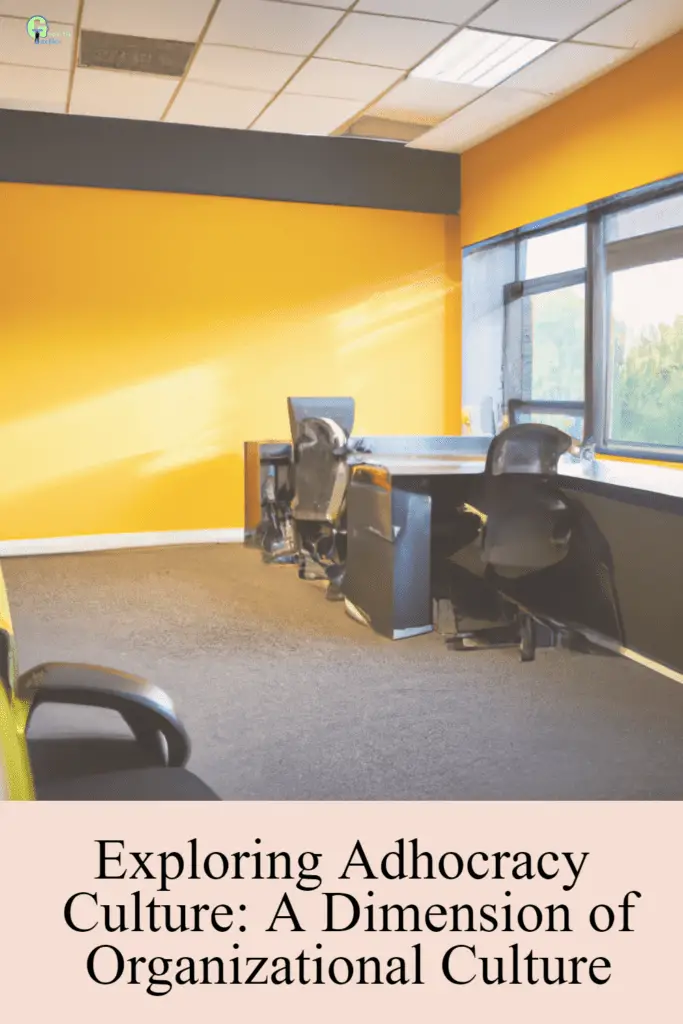Can adhocracy culture be right for your business? If you value innovation and creativity, then the answer may be yes.
This article will take you on a deep dive into the world of adhocracy. Not only will you understand what it is, but you’ll also gain in-depth insights into its advantages, disadvantages, examples of businesses using it, key characteristics, how it contrasts with other organizational culture types, and much more.
Let’s get started!
Jump To Section
What is Adhocracy Culture?

Adhocracy culture is a type of organizational culture that values flexibility, adaptability, and innovation. In a company with an adhocracy culture, decision-making is decentralized, and each individual is encouraged to take risks, explore new ideas, and embrace change. This ever-changing business environment leads to a dynamic workplace culture that thrives on creativity, experimentation, and rapid response to market conditions.
An adhocracy organizational structure often features a flat organizational hierarchy with few layers of management, allowing employees at all levels to have a say in the decision-making process. This sense of ownership among employees nurtures a high level of engagement, job satisfaction, and shared responsibility for the company’s success.
Instead of relying on traditional corporate structures or following rigid formal procedures, adhocracy culture prioritizes adaptability, innovation, and a quick reaction to the ever-changing business world. This type of culture fosters a competitive advantage for organizations ready to embrace change and adapt to future business trends, making them agile in an increasingly fast-paced market.
The Characteristics of Adhocracy Culture
Adhocracies are founded on a unique combination of principles, forming what’s known as adhocracy culture. Here are the key characteristics that define adhocracy culture within the organization:
- Flexibility and Adaptability: Adhocracy culture encourages an adaptable work environment where change is not just expected but celebrated. This ability to pivot smoothly in response to market conditions is a distinctive trait of adhocracy culture.
- Decentralized Decision-Making: With adhocracy, decisions are made organically by individuals or teams best suited to address specific problems or challenges, rather than strictly following a hierarchical chain of command.
- Risk-Taking: Adhocracy culture values the willingness to take risks, which employees often do to come up with new ideas or find the best solutions. This culture also promotes resilience and learning from mistakes or failures.
- Innovation and Creativity: Adhocracy culture fosters a culture of innovation, enabling employees to think outside the box and experiment with new ideas. This cultural emphasis leads to creativity and innovation, which can become a company’s competitive advantage.
- Entrepreneurial Spirit: Among employees in adhocracies, there’s often an entrepreneurial mindset. They have a high level of flexibility, and ownership, and are comfortable with changing the usual way of doing things.
- Employee Engagement: Adhocracy culture encourages a strong sense of ownership among employees, which improves employee engagement, job satisfaction, and overall performance.
- Customer Orientation: Due to its agile nature, adhocracy culture enables organizations to quickly respond to customer needs and market trends, enhancing the overall customer experience.
Understanding these characteristics of adhocracy culture can help businesses embrace this dynamic form of organization, foster a culture of innovation within their teams, and stay ahead of the competition.
Advantages of Adhocracy Culture

Adhocracy culture exhibits several benefits that can significantly enhance a company’s culture. Here are some of the key advantages of adhocracy culture:
- Promotes Innovation and Creativity: An adhocracy culture encourages employees to think outside the box and experiment with new ideas, which can lead to groundbreaking innovations and solutions that give the company a competitive edge.
- Increases Adaptability: This type of culture thrives on flexibility and the ability to adapt quickly to changing market conditions or new business trends, allowing organizations to stay one step ahead of the competition in an ever-changing business world.
- Enhances Employee Engagement: By decentralizing decision-making and encouraging risk-taking, an adhocracy culture can increase a sense of ownership among employees, resulting in improved job satisfaction, creativity, and productivity.
- Boosts Responsiveness to Market Changes: Because adhocratic organizations embrace change, they’re likely to respond swiftly to evolving market conditions, customer needs, or technological advancements, keeping the business relevant and ahead of its competitors.
- Encourages Continuous Learning: Adhocracy culture encourages a learning-oriented environment, offering learning and development opportunities for employees. Mistakes are viewed as opportunities to learn, adapt, and grow.
- Fosters Entrepreneurial Spirit: Adhocracy culture nurtures a culture of entrepreneurship, where employees are motivated to take risks, foster innovation, and take on responsibilities usually assigned to management.
Considering these advantages of adhocracy culture, it’s clear that this type of culture can foster a dynamic, creative, and engaged work environment that aligns with business goals.
Disadvantages of Adhocracy Culture
While adhocracy culture promotes flexibility, adaptability, and creativity within an organization, it also has certain disadvantages that may impact organizational efficiency and stability. Here are the key disadvantages of adhocracy culture:
- Lack of Structure: The absence of a well-defined hierarchical structure can lead to confusion or conflict over roles, responsibilities, and decision-making authority.
- Risk of Miscommunication: With decisions often being made organically and quickly, there’s a potential for information gaps or miscommunication, which could lead to inefficiencies or mistakes.
- Potential Overemphasis on Innovation: While fostering creativity and innovation is beneficial, excessive focus can lead to a neglect of routine tasks or processes essential for the organization’s day-to-day operations.
- Increased Risk: Adhocracy’s emphasis on risk-taking can lead to a higher probability of mistakes or failures. While such experiences can be valuable learning opportunities, too many of them may harm business productivity and morale.
- Short-Term Focus: The constant adaptability to market changes might create a focus on short-term goals at the expense of long-term strategic planning.
- Difficulty in Maintaining: An adhocracy culture may be challenging to maintain as the organization grows and traditional rules and hierarchies begin to form.
Understanding these potential disadvantages of adhocracy culture can help an organization consider measures to alleviate these issues while benefiting from an adhocracy’s strengths.
Real-Life Adhocracy Culture Examples

Understanding adhocracy culture, in theory, can be abstract, so let’s delve into real-world examples of organizations known for their strong adhocracy cultures.
Tesla: Under the leadership of Elon Musk, Tesla showcases a type of corporate culture that heavily emphasizes innovation and adaptability. Tesla’s adhocracy culture encourages employees to take risks, come up with new ideas and solutions, ensure a high level of flexibility in design and production processes, and quickly adapt to ever-changing market conditions or technological advancements.
Google: Known for its dynamic and innovative work environment, Google’s adhocracy culture is a driving force for its continuous innovation and success. Employees are encouraged to spend time on their own projects, foster creativity, and explore ideas that fall outside their regular job duties. Google’s culture ensures continuous evolution and adaptability, transforming it into an industry leader.
Spotify: This global music streaming platform embodies an adhocracy culture that promotes a high level of flexibility and creativity among its employees. The company structures teams in small, autonomous groups called “squads” that have the freedom to experiment with new ideas and techniques–a characteristic of adhocracy culture at its finest.
Netflix: Netflix is renowned for its unconventional approach to its organizational culture. The company’s culture, often called an adhocracy, encourages employees to make decisions on their own, encouraging risk-taking and creativity in its operations. In this environment, innovative ideas are prized above all else, and failures are seen as opportunities for learning rather than setbacks.
By putting people, ideas, and adaptability at their core, these companies exemplify the strong sense of ownership among employees, creativity, and risk-taking that characterize adhocracy culture. It’s clear that adhocracy fosters a vibrant and dynamic culture of innovation that can adapt swiftly to changing business conditions, setting them apart from their peers in today’s fast-paced business world.
Comparison with Other Organizational Cultures: Adhocracy vs. Market, Clan, and Hierarchy Cultures
There are generally four types of organizational cultures proposed by the Competing Values Framework: adhocracy, market, clan, and hierarchy. Each has unique traits that make them appropriate for different types of companies or settings.
Adhocracy vs. Market Culture
- Adhocracy culture emphasizes adaptability, flexibility, and creativity where innovation is encouraged, while market culture is performance-centric with a strong emphasis on competition, achieving set targets, and customer focus.
- Companies with a market culture prioritize results but may not be as flexible or as innovative as a company with an adhocracy culture.
Adhocracy vs. Clan Culture
- Clan culture resembles a family-like atmosphere promoting collaboration, trust, and loyalty among its members. Employee development, empowerment, and satisfaction are primary goals. In contrast, adhocracy culture encourages individual initiative, creativity, and risk-taking to drive innovation.
- Adhocracy might lack the strong sense of belonging that clan cultures promote, but it provides employees with more space for individual creativity and innovation.
Adhocracy vs. Hierarchy Culture
- Hierarchy culture is characterized by its formalized and structured work environment where procedures decide actions. Stability, predictability, and efficiency are emphasized in a hierarchy culture, contrasting the dynamic and adaptable adhocracy culture.
- Companies with a hierarchy culture can be less flexible and slower at making decisions compared to those with an adhocracy culture due to their heavy emphasis on rules, regulations, and structured lines of authority.
Understanding Organizational Culture: The Role of Adhocracy in Corporate Culture
Adhocracy culture plays a significant role in shaping corporate culture and the business environment. It strongly emphasizes innovation, flexibility, and adaptability, making it particularly useful in industries and sectors where change is constant and rapid.
By fostering a culture where risk-taking is encouraged, adhocracy can stimulate breakthrough innovation, driving competitiveness and growth. This adaptability is crucial in the modern business world where companies need to rapidly respond to evolving market trends and advances in technology.
Moreover, an adhocracy culture’s decentralized decision-making can inspire a sense of ownership amongst employees, which can lead to increased motivation, engagement, and job satisfaction. It supports a flat organizational structure where everyone’s ideas are valued, promoting a positive workplace environment that nurtures innovation and creative problem-solving.
However, adhocracy’s key strengths can also be potential weaknesses. Without careful management, the focus on fluidity and spontaneous decision-making can lead to uncertainty or an excessive focus on innovation at the expense of daily operations. Likewise, the absence of clear hierarchies and established procedures might result in confusion, misunderstanding, and potential conflict.
However, despite these challenges, a well-implemented adhocracy culture can foster a dynamic and responsive organization that thrives in a volatile, complex business environment. By embracing change, encouraging creativity, and fostering individual initiative, an adhocracy culture can contribute to the vibrant dynamism of an organization’s corporate culture. With the right balance, an organization can reap the benefits of adhocracy while mitigating potential downsides, shaping a vibrant and adaptable workplace that drives sustained success and evolution.
Tips For Implementing an Adhocracy Culture

Build a Supportive Environment
An innovative adhocracy culture thrives in a flexible workplace that encourages creativity and change. This environment attracts individuals who enjoy experimentation, risk-taking, and collaboration.
For instance, a creative tech company might utilize open workspaces to promote spontaneous interactions among employees. Such layouts break down barriers, fostering empowerment and idea sharing. Effective leaders in this setting seek input, listen attentively, and encourage experimentation.
Encourage Flexibility and Autonomy
Encouraging innovation and adapting to market trends thrives in environments where teams can quickly adjust their direction. When individuals have the freedom to make decisions, they often generate innovative solutions that benefit the entire team.
Flexibility goes beyond just having adjustable hours or remote work; it also involves how work is done, who controls it, and the formation of teams. For example, a designer might join a product team for a few weeks before shifting to a new campaign, which helps develop skills and prevents anyone from being stuck in a single role.
Employees enjoy greater control over their work pace and the tools they use, often choosing the challenges they want to tackle. Teams excel when individuals take ownership of their contributions, leading to faster problem-solving and open communication between employees and executives.
A culture of open critique fosters discussions on what should remain or change. This blend of freedom and trust keeps energy high and creative ideas flowing.
Focus on Results Over Procedures
Adhocracy culture excels by prioritizing results over processes, allowing for rapid iteration and response. Teams focus less on rigid procedures and more on achieving outcomes. Employees are empowered to experiment and innovate independently.
This approach requires trust between staff and management, allowing teams to own their successes and failures. Focusing on results doesn’t lead to chaos; instead, it fosters responsiveness to market changes and community needs, particularly in fast-paced environments with complex solutions.
Foster Creativity and Innovation
Adhocracy culture emphasizes innovation and quick adaptation. Teams thrive in an environment that promotes intelligent risk-taking and allows individuals to question direction without fear of retribution.
In an adhocracy, collaboration across fields is encouraged, enabling fresh perspectives. Leaders in these settings guide rather than control, setting clear goals while giving individuals the freedom to choose their own paths.
This empowers anyone with a good idea to test it immediately without lengthy approval processes. Many media and tech companies benefit from this fast, open approach, enhancing their vision and ability to seize new opportunities.
Adhocracy culture fosters trust and value among employees, encouraging them to voice concerns and propose innovative ideas. This leads to a continuous flow of fresh concepts, making the environment dynamic and forward-thinking. In such settings, change is embraced as an everyday part of work.
Promote Collaboration Among Teams
Adhocracy culture enhances teamwork, promoting creativity and quick problem-solving. Teams work together instead of in isolation. This interaction helps prevent stale ideas and accelerates issue resolution, avoiding long waits for approvals.
Regular collaboration occurs in open workspaces or through tools like Slack and Trello, enabling constant communication and file sharing. Trust is crucial; when teams trust each other, they celebrate successes and seek help without hesitation.
Leaders can foster this trust by encouraging experimentation and ensuring all voices are heard. When organizations collaborate, they amplify their successes and generate innovative solutions.
Summary: Key Takeaways on Adhocracy Culture
- Adhocracy culture provides a flexible and dynamic business environment.
- It’s characterized by free-flowing ideas, innovation, and the ability to adapt.
- Some of the advantages include encouraging innovation, fostering creativity, and rapid response to changes.
- However, lack of structure and potential instability are among the main disadvantages.
- Real-life examples shed more light on how adhocracy culture is implemented.
- Adhocracy contrasts with market, clan, and hierarchy cultures, each having distinct characteristics and implications.
- While offering a unique set of benefits, businesses should carefully consider potential challenges before opting for adhocracy.


